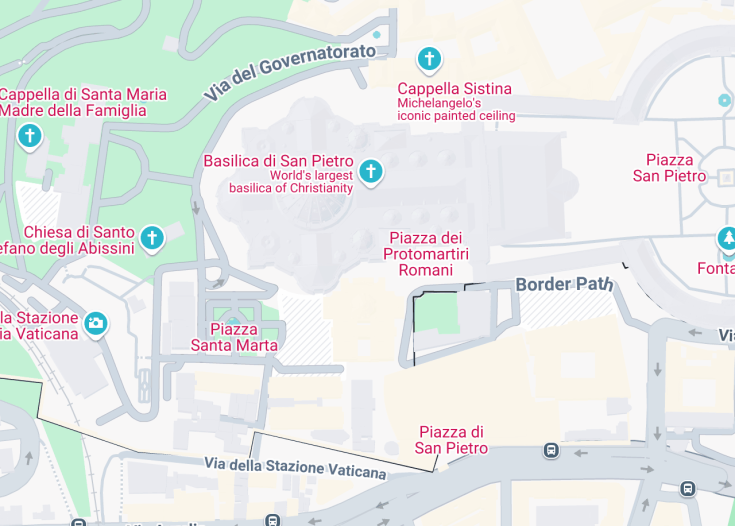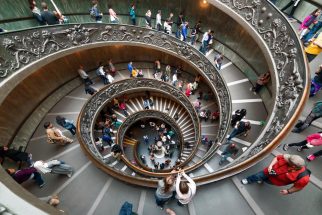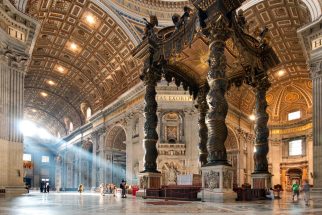Hidden beneath St. Peter’s Basilica lies the Vatican Necropolis, a fascinating historical site that holds the secrets of early Christian Rome and the final resting place of Saint Peter himself. This ancient burial ground dates back to imperial times, featuring a complex of mausoleums filled with intricate frescoes, mosaics, and inscriptions, offering a unique glimpse into the rituals and beliefs of the society that once thrived above it. The Necropolis provides not only a connection to Christian history but also showcases the layered complexities of Roman architectural and artistic achievements.
To make the most out of your visit to the Vatican Necropolis, ensure that you book your tour well in advance, as access is highly restricted and spots are limited to protect the delicate archaeological site.
Wear comfortable shoes and prepare for a cooler climate underground. Taking a small, unobtrusive flashlight might also help in viewing details that are not well-lit.
How to best experience Vatican Necropolis?
Tickets, tours, and activities for Vatican Necropolis are available at these providers:
Click on the logos below to easily compare prices.

Feeling lucky? Try the direct search:
GetYourGuide.com Viator.com Trip.com Expedia.com Tiqets.com Ctrip.com (中文)
Exploring the Hidden City Beneath Vatican City
The Vatican Necropolis is an ancient cemetery located beneath St. Peter’s Basilica in Vatican City. It contains tombs, mausoleums, and streets that date back to Roman times, making it an unparalleled archaeological and historical site. Originally, it was an open-air cemetery situated on a slope, but over centuries, construction transformed the area, burying the necropolis under the basilica. This underground burial place is notable for supposedly housing the tomb of Saint Peter, one of the Twelve Apostles, which attracts scholars and pilgrims alike. Touring the Vatican Necropolis offers visitors a unique glimpse into the early history of Christian Rome and the traditions associated with its burial practices. Due to its delicate nature and archaeological importance, access to the necropolis is restricted, and visits are allowed only by special permission, preserving the sanctity and integrity of this hidden treasure beneath the hustle and bustle of Vatican City.
Guided Tours of the St. Peter’s Tomb
Visitors to the Vatican Necropolis primarily come to see the tomb of Saint Peter. Guided tours, which must be requested in advance due to limited availability, provide an intimate exploration of this sacred site. These tours delve into the history and significance of the necropolis, explaining the structures and artifacts discovered over decades of excavations. Highlights include intricate funerary art and inscriptions that shed light on the life and death of individuals from Roman times. The experience is exceptionally immersive, giving visitors a rare look at the beginnings of Christianity and its early followers.
Unveiling the Clivus
The Clivus is one of the most captivating parts of the Vatican Necropolis. This ancient street runs through the heart of the underground cemetery and is lined with tombs and mausoleums. Walking along the Clivus, visitors can feel the historical ambiance, almost as if walking back in time through the everyday lives of Rome’s ancient citizens. This notable feature emphasizes the architectural and cultural continuity from pagan to Christian Rome, illustrating the evolving religious landscape of the city.
Explore the mysteries of the Vatican Necropolis
The Vatican Necropolis is a fascinating destination that appeals primarily to history enthusiasts, culture seekers, and those interested in religious studies. This ancient site, below St. Peter’s Basilica, offers a unique window into early Christian Rome and the tradition surrounding the burial of St. Peter. While the site may be challenging for very young children due to its solemn and scholarly nature, it is ideal for older children, particularly those with a budding interest in history or archaeology, as well as adults of all ages.
Upon descending into the Necropolis, visitors are greeted by an extraordinary sight of well-preserved ancient Roman tomb structures, detailed frescoes, and inscriptions that tell tales of the past. The air of mystery is palpable as guests walk through the narrow pathways lined with ancient burial sites. It is not only a journey back in time but also an opportunity to reflect on the historical significance of one of Christianity’s holiest sites.
When to visit the Vatican Necropolis
The Necropolis is best visited during the less crowded months, from November to February, as visitors can ponder the artifacts and the ambiance more intimately without the rush of the high tourist season. However, the site is fascinating throughout the year, particularly during religious holidays when the Vatican City is imbued with a deeply spiritual atmosphere.
[h4]Annual Event Highlight[/h4]
Every year, on the Feast of Saints Peter and Paul in late June, the Vatican offers special services and events, making it an exceptional time to explore the Necropolis as part of a broader cultural and spiritual experience.
Accessibility and limitations at the Vatican Necropolis
The uniqueness of the Vatican Necropolis also comes with a set of limitations that are important to note.
Accessibility
Limitations
- Advance booking is required.
- Visitor numbers are strictly limited per day.
- Photography is not allowed inside the Necropolis.
Notes to visitors
- Large bags and backpacks must be checked in at the entrance.
- It is advisable to wear comfortable shoes as the tour involves a lot of walking.
General informations
Details for your visit to Vatican Necropolis
Location
The Vatican Necropolis is situated beneath St. Peter’s Basilica. Nearby landmarks include the Vatican Museums and the Sistine Chapel, which provide context and depth to the overall experience.
Address: Piazza San Pietro, Vatican City
Opening hours
The Necropolis is open from 9:00 AM to 6:00 PM every day except Sundays and religious holidays when it is closed.
Reaching the Vatican Necropolis
Visitors can reach the Vatican Necropolis easily from major nearby cities. Here is how:
Car
Driving from major accommodation areas provides flexibility for visitors. Here are common routes:
| Route | Distance | Travel time |
|---|---|---|
| From Rome Center | 4 miles (6.4 Km) | 20 minutes |
| From Ciampino Airport | 19 miles (30.5 Km) | 40 minutes |
| From Fiumicino Airport | 21 miles (33.8 Km) | 45 minutes |
Public Transport
Buses and metro services conveniently connect Rome to the Vatican. Estimated travel times from key locations are similar to those by car, ensuring accessibility for those who prefer not to drive.
Nearby Attractions
Exploring around the Vatican Necropolis can be complemented with visits to nearby attractions, sorted by proximity:
- Sistine Chapel – 500 meters (0.3 miles)
- Vatican Museums – 800 meters (0.5 miles)
- Castel Sant’Angelo – 900 meters (0.6 miles)
- Piazza Navona – 2 km (1.2 miles)
- Spanish Steps – 2.8 km (1.7 miles)
- Pantheon – 2 km (1.2 miles)
- Trevi Fountain – 3 km (1.9 miles)
- Colosseum – 4.5 km (2.8 miles)
- Forum Romanum – 4 km (2.5 miles)
- Campo de’ Fiori Market – 2 km (1.2 miles)
- Trastevere – 3.5 km (2.2 miles)
- Palazzo Venezia – 3.8 km (2.4 miles)
Common questions
What is the history behind the Vatican Necropolis?
Can you explain the artwork and decorations in the Vatican Necropolis?
What are the different areas within the Vatican Necropolis?
How are tours of the Vatican Necropolis organized?
What are the key archaeological findings in the Vatican Necropolis?
How is the Vatican Necropolis preserved?
What role does the Vatican Necropolis play in religious studies?
What are the cultural impacts of the Vatican Necropolis on modern society?
Is photography allowed inside the Vatican Necropolis?
What safety measures are in place at the Vatican Necropolis?
How can scholars gain access to study the Vatican Necropolis?
What are the major myths and legends associated with the Vatican Necropolis?

Is the Vatican Necropolis in Vatican City worth visiting?
The Vatican Necropolis lies beneath St. Peter’s Basilica, housing ancient tombs dating back to Roman times. This site is not just a visit; it’s a journey through the deep roots of Christian history. Here you find what is traditionally recognized as the tomb of St. Peter, making it a pilgrimage site for many. However, the atmosphere inside the necropolis is heavy and may not charm everyone. Accessibility is limited; visitors need to schedule tours well in advance, and those with mobility issues might find it challenging to navigate the tight, confining spaces. Furthermore, the subject matter—a silent city of the dead—though fascinating, can be overwhelming. This makes the necropolis a more suitable visit for those deeply interested in archaeology and Christian history than the casual tourist.




